Skylights – the easy button for importing sunlight – are a pretty convenient way to bring in lots of sunlight into a specific area of a home even though they can throw a wrench on home performance new or existing. A good architect can always to get natural light deep into a new, moderately sized home without using skylights. But for existing homes, the Siren song is strong as orientation, shape and window openings are pre-determined.
The seduction of natural light suffusing living space is strong and few area aware of the consequences that can range from overheating in summer, condensation and draftiness in winter, peeling paint, rain leaks or ice buildup are just some of the real consequences if design and installation aren’t done carefully. So if considering, at the very least, have quick look through what we see are common problems associated with skylights.
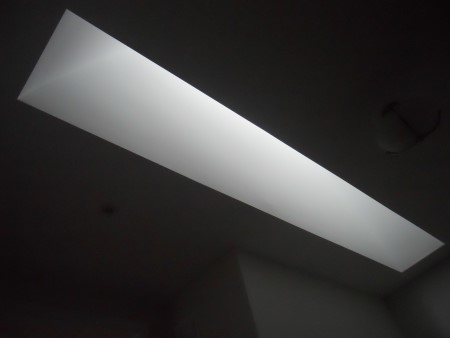
Beautiful, natural light… our connection to the outside world. This skylight has a pyramid-shaped “tube” connecting the ceiling plane of the 2nd floor to the roof-line and curb of the skylight. The base of the pyramid was 12′ long and another 12′ high and 2′ wide. That’s ~300 square feet of wall area that wasn’t accounted for in the home’s HVAC design losses.
There’s a lot of star power on the home building and renovating circuit in Canada, but no one offers more practical considered advice than Jon Eakes who’s been at this for most of his professional life. Jon has a number of great articles on the topic of skylights for a cold climate and doesn’t mince words for selecting a skylight if it can’t be avoided. We agree, the insulated curb above the roof line gets short shrift too.
In our diagnostic services over the years we’ve had numerous complaints of drywall finishes and paint drooping off the ceiling, to water dripping off the skylight, frost on the skylight and ice dams near skylights; no shortage of pain and discomfort. Most often, the tube connecting the room to the roof hole needs better air sealing and insulating, but quite often, its the skylight itself or just the sheer length of the “tube” that connects inside to outside. That ‘tube’ needs to be continuously insulated from ceiling to roof line and no air leaks in between – this is hard to do with trusses and framing getting in the way. Often spray foam is used successfully but do check over the work.
The longer the ‘tube’ the more orphaned (colder) the skylight becomes and the more prone it is to condense indoor humidity. Some builders and designers suggest that the answer is to install a register in the tube just under the skylight to ‘wash’ it with warm conditioned air. This option would be appealing if it weren’t or the fact that running a duct through an attic poses its own problems. If your home currently suffers form condensation or general discomfort in winter, Eakes suggestion of installing a lens at ceiling height is brilliant.
Here are some of the issues we’ve seen over the years:
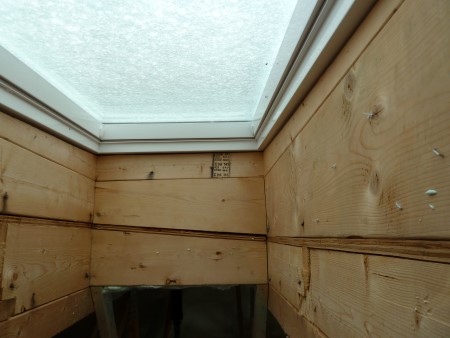
- The band of plywood roof sheathing can be seen separating the insulated hot roof underneath and the curb above the roof line. Insulating above the curb is equally as important. In the case above, the hot roof meant that the tube didn’t need to be insulated.
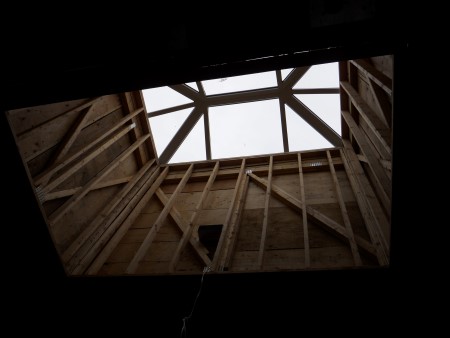
This skylight is more traditional looking but has a huge ‘tube’ running through the attic. Detailing of this tube often gets short shrift… because its in the attic and nobody cares!
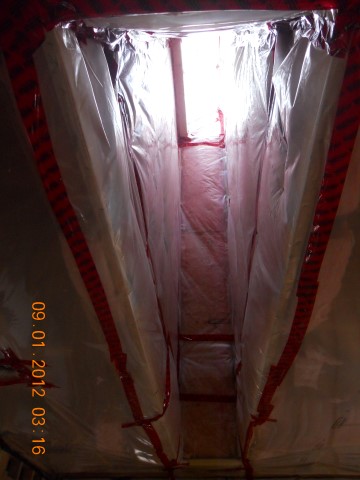
This is the same skylight that’s in the video below. I was there when a pair of Québeckers had to drywall the 2′ wide ‘tube’. It was nearly 2 stories in height!
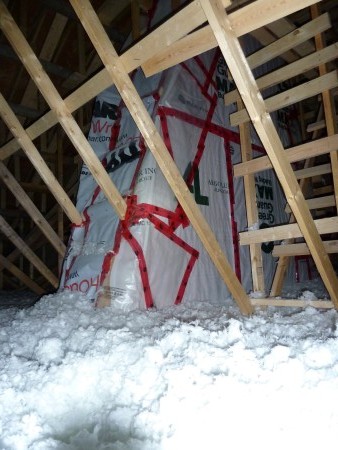
The skylight ‘tube’ from the attic side rarely gets well insulated and to reduce heat loss along its length, best if well insulated and sealed at top against roof line. Note the bottom corner has poly vapour barrier on the outside, on the cold side, this is in Canada – see what I mean by short shrift?
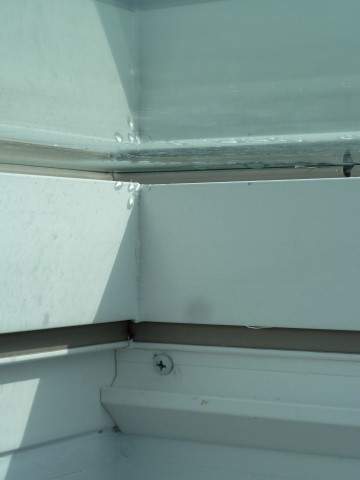
This skylight was condensing humidity in the house under construction which has typically high humidity with new curing concrete, drywall mud and latex paint. What’s concerning is that this skylight was in a bathroom ceiling and it will be humid. See the condensation near the breach? With the house being depressurised by blower door, a whistling sound could be heard coming from the gap in the butt-edge of the IGU to frame seal – that’s NFG. See video below!
